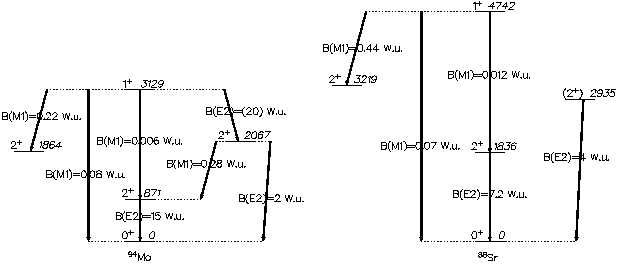| A Scissors-Like State on Top of the Quadrupole Vibrational State in 88Sr D,H | |||
|---|---|---|---|
|
L. Käubler, H. Schnare, R. Schwengner, H. Prade, F. Dönau, E. Grosse,
K.D. Schilling, A. Wagner
and the Köln1 - Darmstadt2 - Sofia3 collaboration |
|||
|
A (g,g') experiment on 88Sr was performed at the S-DALINAC accelerator of the TU Darmstadt with bremsstrahlung of 6.7 MeV endpoint energy using two EUROBALL CLUSTER detectors. In the search for the 1- two-phonon state in the N=50 nucleus 88Sr we found surprisingly Jp = 1+ for the 4.742 MeV state [1] and a relatively large value of B(M1)=0.07 W.u. for the 4.742 MeV transition (Fig. 1) which is not reproduced by the quasiparticle-phonon model [2].  Fig. 1 Comparison of 94Mo and 88Sr.
Fig. 1 Comparison of 94Mo and 88Sr.
In order to give an interpretation for the 1+ state at 4.742 MeV, the picture of a new excitation mode called dynamic scissors mode is proposed: a superposition of the normal scissors mode (scissors-like isovector vibration of the deformed proton and neutron systems) with the dynamically deformed quadrupole vibrational state in a spherical nucleus. This idea is suported by the following two arguments: (i) For the first 2+ state in 88Sr a deformation of d = 0.11 is obtained for the maximum elongation. Based on empirical estimates (est) [3] the normal scissors mode in 88Sr would occur for d = 0.11 at the centroid of energies of Eest(1sc+) = 3.17 MeV with a total strength of Best(M1;1sc+®01+) = 0.03 W.u.. For the dynamic scissors mode state E(1dsc+) in 88Sr one gets the estimate Eest(1dsc+) = Eexp(21+)+ Eest(1sc+) = 5.01 MeV. The estimates of 5.01 MeV and 0.03 W.u. are in fair agreement with the experimental results given above. (ii) There are many similarities of the deexcitation of the 4.742 MeV state in the spherical nucleus 88Sr with that of the mixed symmetry scissors-like 1+ms state in the deformed N=52 nucleus 94Mo [4], and also for the first three 2+ states (Fig. 1). The 1+ state in 94Mo is considered to be the scissors mode in this nucleus having the structure (2+1 Ä 2+ms), where 2+1 corresponds to the phonon of the isoscalar quadrupole vibration and 2+ms is the phonon of the isovector quadrupole vibration. For 88Sr the energy sum of the 2+ isoscalar quadrupole vibrational state (1.836 MeV) and the newly observed possible 2+ms isovector quadrupole vibrational state (2.935 MeV) results to 4.771 MeV in well accordance to 4.742 MeV for the 1+ state. In summary, the 1+ state at 4.742 MeV in the spherical N = 50 nucleus 88Sr is a fingerprint for the existence of a scissors-like state. The picture of the dynamic scissors mode could be a schematic approach for this excitation giving a rough approximation to the real situation. The reality may be a complicated superposition of an isoscalar and isovector quadrupole vibration.
1 Institut für Kernphysik, Universität zu Köln, 50937 Köln
References
[1] L. Käubler et al., Eur. Phys. J. A 7 (2000) 15
|